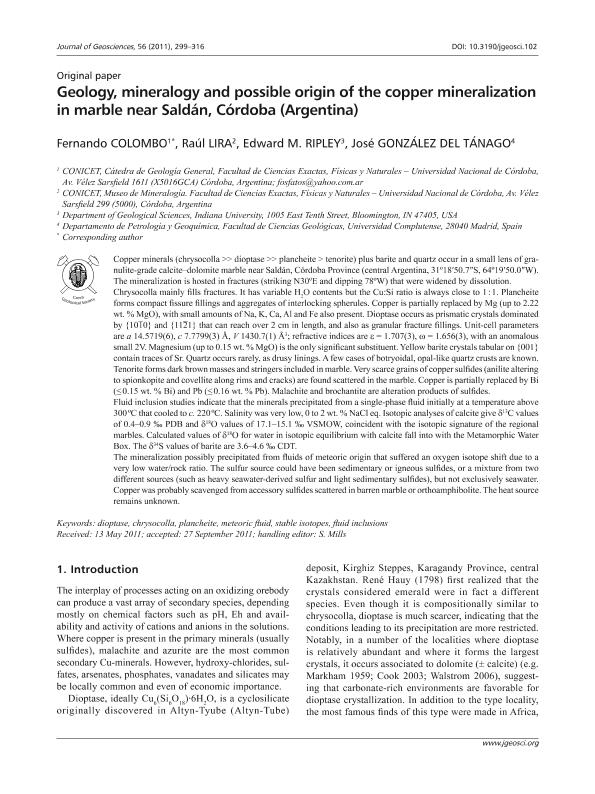Mostrar el registro sencillo del ítem
dc.contributor.author
Colombo, Fernando

dc.contributor.author
Lira, Raul

dc.contributor.author
Ripley, Edward

dc.contributor.author
González del Tánago, José
dc.date.available
2018-07-17T15:43:07Z
dc.date.issued
2011-11
dc.identifier.citation
Colombo, Fernando; Lira, Raul; Ripley, Edward; González del Tánago, José; Geology, mineralogy and possible origin of the copper mineralization in marble near Saldán, Córdoba (Argentina); Czech Geological Society; Journal of Geosciences; 56; 3; 11-2011; 299-316
dc.identifier.issn
1802-6222
dc.identifier.uri
http://hdl.handle.net/11336/52394
dc.description.abstract
Copper minerals (chrysocolla ≫ dioptase ≫ plancheite > tenorite) plus barite and quartz occur in a small lens of granulite- grade calcite-dolomite marble near Saldán, Córdoba Province (central Argentina, 31°18′50.7″S, 64°19′50.0″W). The mineralization is hosted in fractures (striking N30°E and dipping 78°W) that were widened by dissolution. Chrysocolla mainly fills fractures. It has variable H2O contents but the Cu:Si ratio is always close to 1: 1. Plancheite forms compact fissure fillings and aggregates of interlocking spherules. Copper is partially replaced by Mg (up to 2.22 wt. % MgO), with small amounts of Na, K, Ca, Al and Fe also present. Dioptase occurs as prismatic crystals dominated by {10 10} and {11 21} that can reach over 2 cm in length, and also as granular fracture fillings. Unit-cell parameters are a 14.5719(6), c 7.7799(3) Å, V 1430.7(1) Å3; refractive indices are ε = 1.707(3), ω = 1.656(3), with an anomalous small 2V. Magnesium (up to 0.15 wt. % MgO) is the only significant substituent. Yellow barite crystals tabular on {001} contain traces of Sr. Quartz occurs rarely, as drusy linings. A few cases of botryoidal, opal-like quartz crusts are known. Tenorite forms dark brown masses and stringers included in marble. Very scarce grains of copper sulfides (anilite altering to spionkopite and covellite along rims and cracks) are found scattered in the marble. Copper is partially replaced by Bi (≤ 0.15 wt. % Bi) and Pb (≤ 0.16 wt. % Pb). Malachite and brochantite are alteration products of sulfides. Fluid inclusion studies indicate that the minerals precipitated from a single-phase fluid initially at a temperature above 300°C that cooled to c. 220°C. Salinity was very low, 0 to 2 wt. % NaCl eq. Isotopic analyses of calcite give δ13C values of 0.4-0.9 ‰ PDB and δ18O values of 17.1-15.1 ‰ VSMOW, coincident with the isotopic signature of the regional marbles. Calculated values of δ18O for water in isotopic equilibrium with calcite fall into with the Metamorphic Water Box. The δ34S values of barite are 3.6-4.6 ‰ CDT. The mineralization possibly precipitated from fluids of meteoric origin that suffered an oxygen isotope shift due to a very low water/rock ratio. The sulfur source could have been sedimentary or igneous sulfides, or a mixture from two different sources (such as heavy seawater-derived sulfur and light sedimentary sulfides), but not exclusively seawater. Copper was probably scavenged from accessory sulfides scattered in barren marble or orthoamphibolite. The heat source remains unknown.
dc.format
application/pdf
dc.language.iso
eng
dc.publisher
Czech Geological Society
dc.rights
info:eu-repo/semantics/openAccess
dc.rights.uri
https://creativecommons.org/licenses/by-nc-sa/2.5/ar/
dc.subject
Chrysocolla
dc.subject
Dioptase
dc.subject
Fluid Inclusions
dc.subject
Meteoric Fluid
dc.subject
Plancheite
dc.subject
Stable Isotopes
dc.subject.classification
Meteorología y Ciencias Atmosféricas

dc.subject.classification
Ciencias de la Tierra y relacionadas con el Medio Ambiente

dc.subject.classification
CIENCIAS NATURALES Y EXACTAS

dc.title
Geology, mineralogy and possible origin of the copper mineralization in marble near Saldán, Córdoba (Argentina)
dc.type
info:eu-repo/semantics/article
dc.type
info:ar-repo/semantics/artículo
dc.type
info:eu-repo/semantics/publishedVersion
dc.date.updated
2018-07-11T17:46:39Z
dc.identifier.eissn
1803-1943
dc.journal.volume
56
dc.journal.number
3
dc.journal.pagination
299-316
dc.journal.pais
República Checa

dc.journal.ciudad
Praga
dc.description.fil
Fil: Colombo, Fernando. Consejo Nacional de Investigaciones Científicas y Técnicas. Centro Científico Tecnológico Conicet - Córdoba. Centro de Investigaciones en Ciencias de la Tierra. Universidad Nacional de Córdoba. Facultad de Ciencias Exactas Físicas y Naturales. Centro de Investigaciones en Ciencias de la Tierra; Argentina
dc.description.fil
Fil: Lira, Raul. Universidad Nacional de Córdoba. Facultad de Cs.exactas Físicas y Naturales. Museo de Geología y Miner.; Argentina
dc.description.fil
Fil: Ripley, Edward. Indiana University; Estados Unidos
dc.description.fil
Fil: González del Tánago, José. Universidad Complutense de Madrid; España
dc.journal.title
Journal of Geosciences
dc.relation.alternativeid
info:eu-repo/semantics/altIdentifier/url/http://www.jgeosci.org/detail/jgeosci.102
dc.relation.alternativeid
info:eu-repo/semantics/altIdentifier/doi/http://dx.doi.org/10.3190/jgeosci.102
Archivos asociados
